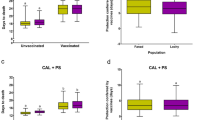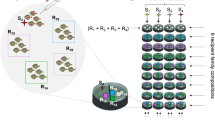Abstract
This paper discussess the hypothesis that a major factor in the epizootics of Salmonella infection in poultry is a declining host genetic diversity. A computer model is described which is based on models that have been previously used to investigate host-pathogen coevolution in cereal crops. It is shown that, as host genetic diversity declines, parasite diversity also declines to a lower equilibrium level. With a highly diverse host, parasite numbers decline to zero. With a homogeneous host population, after an initial decline, there is a rapid increase in parasite numbers, due to the selection of a particularly well adapted parasite strain. This simple computer simulation is used as the basis for a discussion of the literature supporting the suggestion that a major factor in the epizootic of Salmonella in poultry is related to the low genetic diversity of commercial poultry flocks.
Similar content being viewed by others
References
BarrettJ.A. (1980): Pathogen evolution in multilines and variety mixtures - J. Plant Diseases Protection 87: 383–396.
BradleyD.J. (1982): Genetics of resistance to infection with special reference to Leishmaniasis -Trans. Royal Soc. Trop. Med. Hyg. 76: 143–146.
BremermannH.J. (1980): Sex and polymorphism as strategies in host-pathogen interactions - J. Theoret. Biol. 87: 671–702.
BurdonJ.J. (1987): Diseases and plant population biology. Cambridge University Press - Cambridge
CowdenJ.M., LynchD., JosephCA., 0'MahonyM., MawerS.L., RoweB. and BartlettC.L.R. (1989): Case control study of infections with Salmonella enteritidis phage type 4 in England - Brit. Med. J. 299: 771–773.
ForH.H. (1951): Genes for resistance to rust in Victory flax - Agronomy J. 43: 527–531.
GrothJ.V. (1976): Multilines and “super races” a simple model - Phytopathol. 66: 937–939.
GrothJ.Y. and PersonC.O. (1977): Gentic interdependence of host and parasite in epidemics -Ann. New York Acad. Sci. 287: 97–106.
HamiltonW.D., AxelrodR. and TaneseR. (1990): Sexual reproduction as an adaptation to resist parasites (a review) - Proc. Natl. Acad. Sci. USA 87: 3566–3573.
HunterP.R. and IzsakJ. (1990): Diversity studies of Salmonella incidents in some domestic livestock and their potential relevance as indicators of niche width- Epidemiol. Infect. 105: 501–510.
JayakarS.D. (1970): A mathematical model for interaction of gene frequencies in a parasite and its host - Theoret. Population Biol. 1: 140–164.
LeonardK.J. (1977): Selection pressures and plant pathogens - Ann. New York Acad. Sci. 287: 207–222.
LevinS.A. (1983): Some approaches to the modelling of co-evolutionary interactions. In: Nitecki M.H. (ed.). Co-evolution. University of Chicargo Press -Chicago pp. 21–65.
MarshallD.R. and PryorA.J. (1978): Multiline varieties and disease control: I. The “dirty crop” approach with each component carrying a unique single resistance gene - Theoret. Appl. Genet. 51: 177–184.
MayR.M. and AndersonR.M. (1983): Epidemiology and genetics in the co-evolution of parasites and hosts - Proc. Royal Soc. London B 219: 281–313.
ModeC.J. (1958): A mathematical model for the coevolution of obligate parasites and their hosts -Evolution 12: 158–165.
ModeC.J. (1961): A generalised model of a hostpathogen system - Biometrics 17: 386–404.
PutmanR.J. and WrattenS.D. (1984): Principles of Ecology - Croom Helm - London.
RamplingA., AndersonJ.R., UpsonR., PetersE., WardL.R. and RoweB. (1989): Salmonella enteritidis phage type 4 infection of broiler chickens: a hazard to public health - Lancet ii: 436–438.
St LouisM.E., MorseD.L., PotterM.E., DeMelfiT.M., GuzewichJ.J., TauxeR.V. and BlakeP.A. (1988): The emergence of grade A eggs as a major source of Salmonella enteritidis infections - J. Amer. Med. Assoc. 259: 2103–2107.
SimpsonE.H. (1949): Measurement of diversity -Nature 163: 688.
ToobyJ. (1982): Pathogens, polymorphism and the evolution of sex - J. Theoret. Biol. 97: 557–576.
WeatherallD.J., BellJ.I., CleggJ.B., FlintJ., HiggsD.R., HillA.V.S., PasvolG. and TheinS.L. (1988): Genetic factors as determinants of infectious disease transmission in human communities - Proc. Royal soc. London B 321: 327–328.
Author information
Authors and Affiliations
Rights and permissions
About this article
Cite this article
Hunter, P.R. Epizootics of Salmonella infection in poultry may be the result of modern selective breeding practices. Eur J Epidemiol 8, 851–855 (1992). https://doi.org/10.1007/BF00145331
Issue Date:
DOI: https://doi.org/10.1007/BF00145331




